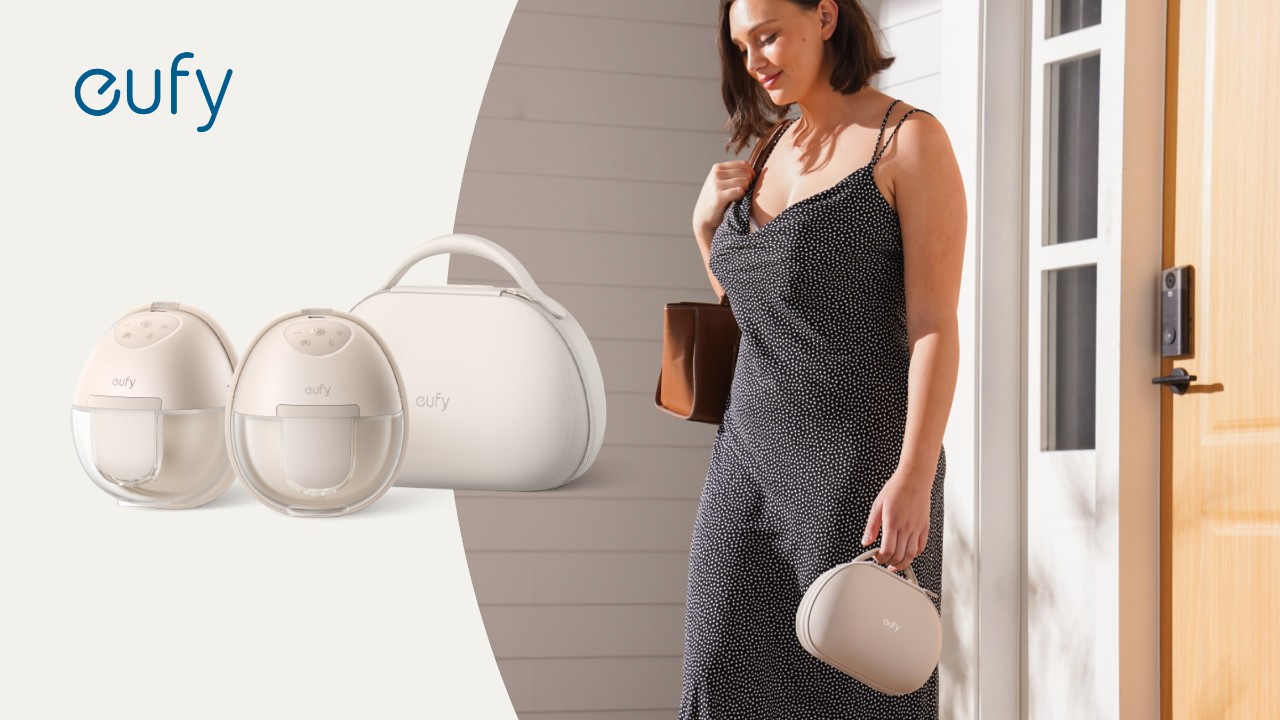Breastfeeding can be challenging for many mothers, with obstacles that go beyond just expressing milk. For many breastfeeding mothers, finding time and space to pump can be a significant hurdle. Data shows that 53% struggle to find a suitable place to pump on the go, and 47% face time constraints that make regular pumping sessions challenging. Hands-free breast pump offer a solution, providing flexibility to pump anywhere, anytime. In this guide, we’ll explore the top hands-free breast pumps of 2025, designed to make breastfeeding easier and more adaptable to a busy lifestyle.
Common Challenges in Pumping
Choosing the right breast pump is crucial for a comfortable and effective pumping experience. Missteps in this selection can lead to several common issues:
1. Nipple Pain
Breast pumps extract milk through suction, involving repetitive pulling and releasing of the nipple and areola. While this is a normal part of the process, improper pump settings or an ill-fitting flange can lead to significant discomfort or even pain. Over time, such strain may cause nipple sensitivity, soreness, or irritation, making pumping sessions increasingly difficult.
2. Clogged Milk Ducts
Blocked milk ducts often occur when milk is not fully expressed, leading to the buildup of residual milk. In some cases, thicker milk with a higher fat concentration may contribute to the blockage, though the primary causes are typically incomplete milk removal, pressure on the breast, or extended intervals between pumping or feeding. This condition can result in breast engorgement, inflammation, pain, swelling, and occasionally fever. When ducts remain clogged, pumping becomes both ineffective and uncomfortable, requiring careful management to resolve the issue and prevent complications such as mastitis.
Understanding these common challenges associated with pumping allows for a more informed and targeted approach when selecting a breast pump, helping to avoid unnecessary discomfort caused by an ill-suited choice.
Factors to Consider When Choosing a Hands-Free Breast Pump
A well-designed pump enhances efficiency, preventing milk stasis and clogged ducts, making the pumping experience more comfortable and effective. Here's a breakdown of the most important aspects to help you make the best choice:
1.Suction Strength:
Opting for a pump with adjustable suction settings and properly fitting flanges can significantly reduce nipple discomfort. While the strongest suction isn’t always the best choice, understanding a pump’s suction strength is important. Opt for pumps with hospital-grade suction strength, typically between 300 and 350 mmHg, as they are generally more efficient. Beyond suction strength, consider the number of suction levels available. Look for models offering at least 7 adjustable suction levels to help you find the most comfortable and effective setting.
2.Flange Size and Comfort:
Selecting the correct flange size is crucial for comfortable and effective milk expression. A properly fitted flange allows the nipple to move freely without excess friction or pain, preventing discomfort and potential damage. Below is a general guideline for matching nipple diameter to flange size:
- 11-13mm Nipple Diameter: Recommended flange size is 15mm
- 13-15mm Nipple Diameter: Recommended flange size is 17mm
- 15-17mm Nipple Diameter: Recommended flange size is 19mm
- 17-20mm Nipple Diameter: Recommended flange size is 21mm
- 20-23mm Nipple Diameter: Recommended flange size is 24mm
- 23-26mm Nipple Diameter: Recommended flange size is 27mm

3.Noise Level:
Hands-free breast pumps tend to be quieter than traditional electric models, but noise levels still vary. Ideally, pumps with noise levels between 30-50 decibels are recommended. For reference, 30 dB is similar to a whisper, while 40 dB resembles a refrigerator hum or a quiet office. If you plan to pump in shared spaces or at work, opt for a pump under 50 dB to maintain discretion and avoid disturbing others. Quieter pumps can also help create a calmer, more relaxing pumping experience.
4.Battery Life:
Battery life affects how long you can use the pump without recharging. Look for pumps that offer 6-8 pumping sessions on a single full charge, ensuring convenience throughout the day. A long-lasting battery is especially important for those with frequent pumping schedules. Choose a pump with a battery life that aligns with your routine to avoid interruptions.
5.Portability:
Portability is a key advantage of hands-free breast pumps. Choose a pump that is lightweight and compact, making it easy to carry and use on the go. Portable pumps are ideal for mothers who need to express milk while traveling or in various settings.
6.Innovative Features for Comfort:
To help prevent clogged ducts and maintain a healthy milk supply, many brands incorporate innovative designs such as gentle vibration massage and heating functions (like eufy's HeatFlow™ technology). Gentle vibration massage not only helps break down milk clogs quickly but also soothes discomfort caused by engorgement or blocked ducts. The heating function enhances milk flow and prevents clogs, creating a skin-like and more efficient pumping experience. These features enhance comfort and promote better milk flow during pumping sessions.
By considering these factors, you can find the best hands-free breast pump that aligns with your preferences and lifestyle. This approach ensures you choose a pump that is efficient, comfortable, and suitable for your pumping needs.
Top 6 Breastfeeding Hands-Free Pumps
Choosing the right hands-free breast pump can be challenging; but don't worry, here's a list of the top 6 best hands free breast pumps for 2025:
1. Best Overall Hands Free Wearable Breast Pump: eufy Wearable Breast Pump S1 Pro

The eufy wearable breast pump S1 Pro is a game-changer in breastfeeding comfort and efficiency. With innovative HeatFlow™ technology and 300 mmHg hospital-grade suction, it ensures higher efficiency in milk expression. The eufy Baby app and OptiRhythm™ technology enable smart pumping, effortlessly managing sessions for maximum convenience. Featuring soft silicone and 105° angle flanges, it guarantees unmatched comfort during wear. And it allows for discreet pumping anywhere, anytime. Lightweight and capable of holding up to 177ml of milk with easy cleaning. The eufy breast pump ensures a seamless and comfortable breastfeeding experience like never before.
eufy Wearable Breast Pump: Pump Warm for a Better Flow
- The world’s first HeatFlow™ technology revolutionizes pumping for unparalleled comfort.
- Offers up to 300 mmHg hospital-grade suction power for efficient milk extraction.
- prioritizes pumping comfort with uniquely angled 105° flanges and soft silicone.
- Simplifies your pumping routine with the eufy Baby app.
2. Best Quiet Hands Free Breast Pump: Elvie Double Electric Breast Pump
Price: around $550

The Elvie Double Electric Breast Pump is a top choice for its intuitive app and discreet, quiet operation. This wearable pump offers a comfortable fit, allowing you to pump without the noise and bulk of traditional electric pumps. The app provides useful tracking features, making it easy to monitor your pumping sessions. With a battery life of approximately 2.5 hours and a 5-ounce milk capacity per pump, it's designed for efficiency. However, it's important to ensure proper alignment to avoid leakage. Overall, this best hand free breast pump is a reliable and stylish choice for hands-free pumping.
3. Best Affordable Hands Free Breast Pump: Momcozy S9 Double Wearable Breast Pump
Price: around $100

The Momcozy S9 Double Wearable Breast Pump is a budget-friendly option with a range of convenient features. It’s an all-in-one unit with an auto-shutdown feature for safety. With a milk capacity of 6 ounces per pump, it's slightly larger than other wearable pumps. The battery life is nearly 2 hours, which is sufficient for multiple sessions. However, one drawback is that the pump may be visible through clothing, which could be an issue in public settings. Despite this, the Momcozy Double Wearable Breast Pump is an affordable and practical choice for mothers seeking a wearable pump.
4. Best Hands Free Breast Pump for Large Breasts: Willow Go Wearable Breast Pump
Price: around $330

The Willow Go Wearable Breast Pump is designed with nine pumping levels, allowing for a customizable pumping experience. It is HSA- and FSA-eligible, and can be charged via USB for added convenience. The battery life is approximately 1.25 hours, and the milk capacity ranges from 5 to 7 ounces per pump, offering flexibility. Although the pump is quiet at lower levels, it can be noisy at higher pumping levels. Additionally, the app functionality may be limited. Overall, the Willow Go is an excellent choice for mothers with larger breasts who need a customizable and flexible pumping experience.
5. Best Large Capacity Hands Free Breast Pump: Freemie Liberty II Deluxe
Price: around $110

The Freemie Liberty II Deluxe stands out for its large milk capacity of 8 ounces per pump, making it ideal for mothers who need to express more milk in a single session. It has an automatic shutoff timer for added safety, and its quiet operation ensures a discreet pumping experience. The adjustable flange size offers a comfortable fit for various breast sizes. The battery life is approximately 2.5 hours, but it may drain quickly with frequent use. Despite this, the Freemie Liberty II Deluxe is a top choice for mothers seeking a large-capacity wearable breast pump.
6. Best Wearable Breast Pump for Multitasking: Willow 3.0
Price: around $500

The Willow 3.0 is a wearable breast pump designed for multitasking mothers. Its sleek design and 360-degree mobility make it perfect for moms who need flexibility while pumping. With this pump, you can move freely without worrying about spills, thanks to its unique leak-proof milk collection bags. It has fewer parts to clean, simplifying the maintenance process. The automatic switching between stimulation and expression modes ensures efficient milk flow. The battery life supports approximately five 15-minute pumping sessions, providing ample time for daily use. However, the pump's 4-ounce bag capacity is relatively small, and the cost of bag replacements can add up. Despite these drawbacks, the Willow 3.0 is an excellent choice for busy moms seeking a hands-free and versatile breast pump.
Are Hands-Free Breast Pumps Worth It?
Hands-free breast pumps have become a popular choice among breastfeeding mothers due to their convenience and flexibility. But are they worth the investment? Let’s explore their key benefits to help you decide:
- Freedom to Move: One of the most significant benefits of hands-free breast pumps is the freedom to move while pumping. This flexibility allows mothers to multitask, whether it's caring for a baby, working, or doing household chores, without being tied to a stationary pumping setup.
- Reduced Hand Fatigue: Hands-free breast pumps reduce the strain on your hands and wrists. Traditional manual breast pumps require repetitive squeezing, which can lead to hand fatigue. Hands-free pumps automate the pumping process, allowing you to pump with minimal effort.
- Quiet Operation: Hands-free breast pumps generally operate more quietly than traditional electric pumps. This can be beneficial for mothers who need to pump in a shared space without causing a disturbance. The quieter operation also contributes to a more relaxed pumping experience.
- Efficient Milk Expression: Many hands-free breast pumps are designed to efficiently express milk, with technology that mimics a baby's natural sucking pattern. This can lead to improved milk flow and shorter pumping sessions, providing a more effective way to express milk.
- Portability: Hands-free breast pumps are typically designed to be compact and portable, making them ideal for use on the go. They are often lightweight and easy to carry, allowing you to pump in various locations without the need for electrical outlets or bulky equipment.
- Flexibility in Pumping Position: Hands-free breast pumps allow you to pump in various positions, offering greater flexibility. This can be especially helpful for mothers who find certain pumping positions uncomfortable. The ability to adjust your position while pumping can lead to a more comfortable experience.
- Compatibility with Nursing Bras: Many hands-free breast pumps are designed to fit inside nursing bras, providing a secure and convenient way to pump. This compatibility eliminates the need for additional pumping gear, streamlining the process and making it easier to pump discreetly at home or in private spaces.
If convenience, comfort, and flexibility are priorities in your breastfeeding journey, hands-free breast pumps can be a worthwhile investment. Their features cater to the needs of modern mothers, making pumping more manageable and stress-free.
Related Blogs
Check out these articles for more information:
Conclusion
Hands-free breast pumps offer a convenient and flexible way to express breast milk. By choosing one of the top 6 hands-free breast pumps for 2025 in this blog and considering key factors like pumping efficiency, comfort, and portability, you can find the right pump to suit your needs. The best hands free breast pump provides freedom to move and discreet pumping, making it a valuable addition to your breastfeeding toolkit.
FAQs
Are hands free breast pumps better?
Hands-free breast pumps offer significant advantages over traditional pumps, such as greater flexibility and portability. They can be better for mothers who need to multitask while pumping.
What are the disadvantages of wearable pumps?
Wearable pumps, while convenient, can have some disadvantages. They might not be as efficient as traditional electric pumps, requiring longer pumping sessions. Wearable pumps may also be more noticeable under clothing, limiting their use in public settings.
Does insurance cover hands free breast pump?
Insurance may cover hands-free breast pumps, but it often depends on the specific insurance plan and provider. Under the Affordable Care Act (ACA) in the United States, many insurance plans are required to cover the cost of breast pumps, but coverage details can vary. To find out if a hands-free pump is covered, check your insurance policy or contact your provider. Some insurers also work with medical supply companies that offer a range of covered breast pump options.















